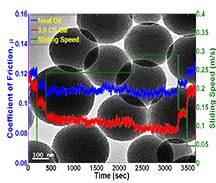Sub-micrometer carbon spheres reduce engine friction as oil additive
March 4, 2015
 |
|
This image taken with an electron microscope shows that tiny carbon spheres added to motor oil reduce friction and wear typically seen in engines by as much as 25 percent, suggesting a similar enhancement in fuel economy. Purdue researchers also have shown how to potentially mass-produce the spheres. (Purdue University image) |
WEST LAFAYETTE, Ind. – Tiny, perfectly smooth carbon spheres added to motor oil have been shown to reduce friction and wear typically seen in engines by as much as 25 percent, suggesting a similar enhancement in fuel economy.
The researchers also have shown how to potentially mass-produce the spheres, making them hundreds of times faster than previously possible using ultrasound to speed chemical reactions in manufacturing.
"People have been making these spheres for about the last 10 years, but what we discovered was that instead of taking the 24 hours of synthesis normally needed, we can make them in 5 minutes," said Vilas Pol, an associate professor of chemical engineering at Purdue University.
The spheres are 100-500 nanometers in diameter, a range that generally matches the "surface roughness" of moving engine components.
"So the spheres are able to help fill in these areas and reduce friction," said mechanical engineering doctoral student Abdullah A. Alazemi.
Tests show friction is reduced by 10 percent to 25 percent when using motor oil containing 3 percent of the spheres by weight.
Findings were detailed in a research paper appearing online in February in the American Chemical Society journal ACS Applied Materials & Interfaces. The paper was authored by Alazemi; chemical engineering postdoctoral research associate Vinodkumar Etacheri; doctoral student Arthur D. Dysart; engineer Lars-Erik Stacke, from SKF Engineering & Research Centre in Göteborg, Sweden; Pol; and Farshid Sadeghi, Cummins Distinguished Professor of Mechanical Engineering.
"Reducing friction by 10 to 25 percent would be a significant improvement," Sadeghi said. "Many industries are trying to reduce friction through modification of lubricants. The primary benefit to reducing friction is improved fuel economy."
Friction is greatest when an engine is starting and shutting off, so improved lubrication is especially needed at those times.
"Introducing microspheres helps separate the surfaces because the spheres are free to move," Alazemi said. "It also is possible that these spheres are rolling and acting as little ball bearings, but further research is needed to confirm this."
Findings indicate adding the spheres did not change the viscosity of the oil.
"It's very important not to increase the viscosity because you want to maintain the fluidity of the oil so that it can penetrate within engine parts," Alazemi said.
The spheres are created using ultrasound to produce bubbles in a fluid containing a chemical compound called resorcinol and formaldehyde. The bubbles expand and collapse, generating heat that drives chemical reactions to produce polymer particles. These polymeric particles are then heated in a furnace to about 900 degrees Celsius, yielding the perfectly smooth spheres.
"A major innovation is that professor Pol has shown how to make lots of these spheres, which is important for potential industrial applications," Sadeghi said.
Etacheri said, "Electron microscopy images and Raman spectra taken before and after their use show the spheres are undamaged, suggesting they can withstand the punishing environment inside engines and other machinery."
Funding was provided by Purdue's School of Chemical Engineering. Electron microscopy studies were performed at the Birck Nanotechnology Center in Purdue's Discovery Park.
Future research will include work to determine whether the spheres are rolling like tiny ball bearings or merely sliding. A rolling mechanism best reduces friction and would portend well for potential applications. Future research also will determine whether the resorcinol-formaldehyde particles might themselves be used as a lubricant additive without heating them to produce pure carbon spheres.
Writer: Emil Venere, 765-494-4709, venere@purdue.edu
Sources: Vilas G. Pol, 765-494-0044, vpol@purdue.edu
Farshid Sadeghi, 765-494-5719, sadeghi@purdue.edu
Note to Journalists: The research papers are available from Emil Venere, 765-494-4709, venere@purdue.edu
ABSTRACT
Ultrasmooth Submicrometer Carbon Spheres as Lubricant Additives for Friction and Wear Reduction
Abdullah A. Alazemi†, Vinodkumar Etacheri‡, Arthur D. Dysart‡, Lars-Erik Stacke§, Vilas G. Pol*,‡ and Farshid Sadeghi*,†
†School of Mechanical Engineering, Purdue University
‡School of Chemical Engineering, Purdue University
§SKF Engineering & Research Centre, Knowledge & Simulation Tools
*E-mail: vpol@purdue.edu
Ultrasmooth submicrometer carbon spheres are demonstrated as an efficient additive for improving the tribological performance of lubricating oils. Carbon spheres with ultrasmooth surfaces are fabricated by ultrasound assisted polymerization of resorcinol and formaldehyde followed by controlled heat treatment. The tribological behavior of the new lubricant mixture is investigated in the boundary and mixed lubrication regimes using a pin-on-disk apparatus and cylinder-on-disk tribometer, respectively. The new lubricant composition containing 3% carbon spheres suspended in a reference SAE 5W30 engine oil exhibited a substantial reduction in friction and wear (10 to 25%) compared to the neat oil, without change in the viscosity. Microscopic and spectroscopic investigation of the carbon spheres after the tribological experiments illustrated their excellent mechanical and chemical stability. The significantly better tribological performance of the hybrid lubricant is attributed to the perfectly spherical shape and ultrasmooth surface of carbon sphere additive filling the gap between surfaces and acting as a nanoscale ball bearing.

